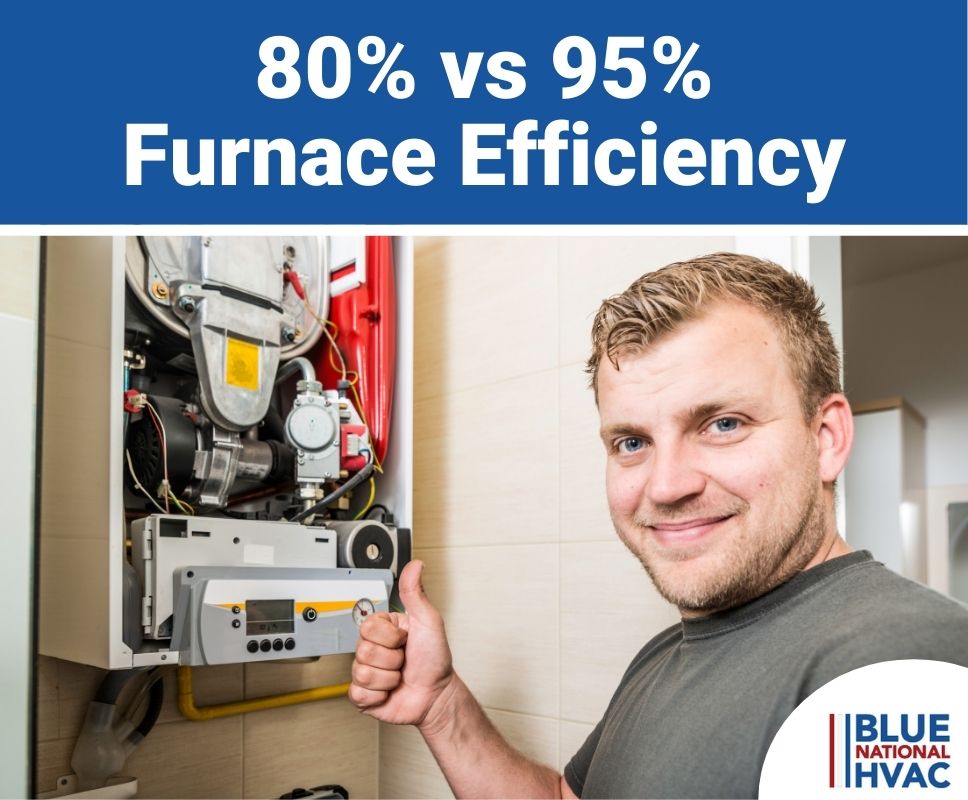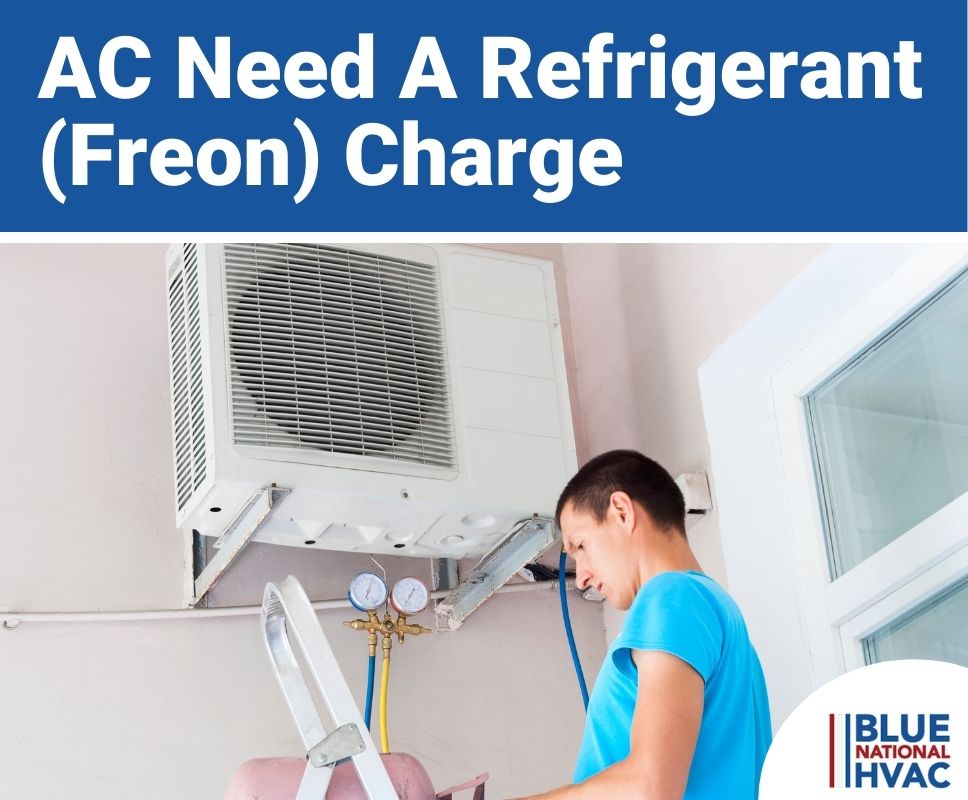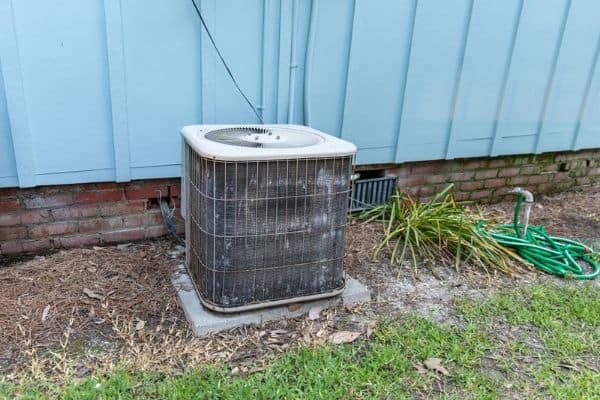And much more!
So, if you’re looking for answers on the best way to heat your home, keep reading our detailed guide below to get answers to all of your questions!
Contents (Click To Jump)
Difference Between 80% vs 95% Efficiency Furnace
The differences between 80% and 95% efficient furnaces are more than the 15% difference you just determine through easy subtraction. While they both force heated air through the ductwork of your home, there are various factors that differ: construction, price, and even how they are installed in your home.
Most homeowners understand that 95% energy efficiency is better and probably costs more. While they are absolutely correct with that assessment, there’s a lot more to the story than that.
Because an 80% and 95% efficient model has different designs, they are each tailored better to different climates, homes, and installation locations in the house.
We cover all of the top differences you should consider when comparing an 80% furnace to a 95% efficiency one.
Efficiency and Heating Costs
Of course, the main difference between the 80% and 95% efficient natural gas furnace is in the numbers. But what exactly do these numbers mean? The 80% and 95% energy efficiency numbers indicate the Annual Fuel Utilization Efficiency (AFUE) ratio.
The AFUE represents the fuel the furnace uses compared to the amount of heat it produces over the entire year. For example, in the case of the 80% AFUE furnace, for every 10 BTUs of fuel it burns, it produces 8 BTUs of heat (on average).
So what does this efficiency difference mean to homeowners? Mainly, it means that an 80% AFUE furnace will use 15% more energy than a 95% AFUE furnace, and its energy bills will be 15% higher too.
Besides energy savings, there are other differences that homeowners may notice, too, like noise levels and indoor comfort levels and savings on repair costs.
Indoor Comfort Levels
Furnaces with better efficiencies provide homes with a better comfort level. For example, compared to an 80% single-stage furnace, high-efficiency 95% furnaces tend to be two-stage units, which run for longer at a lower heat setting.
By running longer at a lower setting, a two-stage furnace is able to provide more consistent heat control, often within 1°F of the setting on your thermostat.
Additionally, since the two-stage furnace usually runs for more extended periods, it reduces cold spots in the home. Lastly, if a two-stage furnace is paired with a built-in humidifier, it provides better humidity control in the home too.
However, both 80% and 95% AFUE furnaces are available in both single-stage and two-stage configurations. So if you were to compare a 95% single-stage unit to a 95% two-stage unit, obviously, they have the same efficiencies, but the two-stage unit would provide better comfort levels.
Here is how single-stage and two-stage furnaces compare with 80% and 95% efficiencies:
| Lower Efficiency, Excellent Comfort 80% AFUE Two-stage furnace | High Efficiency, Excellent Comfort 95% AFUE Two-stage furnace |
| Lower Efficiency, Moderate Comfort 80% AFUE Single-stage furnace | High Efficiency, Moderate Comfort 95% AFUE Single-stage furnace |
Noise
With different furnace energy efficiencies come different sound levels. For example, units with higher efficiencies run for shorter periods, meaning there are running sounds less often.
Or they run for a lengthier time but at a slower speed if they’re a two-stage unit. In this case, the furnace is very quiet.
More often than not, 95% AFUE furnaces create less noise than their 80% AFUE counterparts. This is true whether you are comparing two-stage or single-stage units.
Upfront Furnace Cost
Cost is one of the significant differences between 80% and 95% AFUE furnaces. Additionally, the heat stages and blower motor type play an essential role in the system costs.
Here are the average costs of 80% & 95% furnaces with different heat stages and blower motors.
| AFUE Ratio | 80% Furnace Cost | 95% Furnace Cost |
| Single-stage with multi-speed fan | $600 to $1,100 | $950 to $1,800 |
| Two-stage with multi-speed fan | $900 to $1,300 | $1,200 to $1,700 |
| Two-stage with variable-speed fan | $1,000 to $1,700 | $1,500 to $2,400 |
The price ranges in the above table vary by the physical dimensions, heating BTUs, and the airflow direction (upflow, downflow, and horizontal). For example, furnaces with a 95% efficiency almost always cost more than 80% furnaces when all other features, size, specifications, etc., are equal.
Installation Costs
The installation costs of 80% and 95% AFUE furnaces are about the same for a brand new installation in a new house (with a high-efficiency one maybe costing a bit less).
On the other hand, if you have an existing 80% AFUE furnace in your home and want to upgrade to a 95% AFUE furnace, you will have to pay for extra installation materials- primarily the vent and drain along with the combustion air supply.
Vent and Drain
Furnaces with all levels of efficiency need a vent for the exhaust air. This exhaust air carries combustion gases, including carbon monoxide and carbonic acid, a very corrosive byproduct of natural gas combustion. Additionally, some heat is lost in this process too. The way 80% and 95% furnaces exhaust is very different.
Furnaces with 80% AFUE vent through a flue or chimney in the home, and because they lose 20% of their heat through it, the air is scorching- around 400°F. Since it is such hot air, all the vapor laced with carbonic acid is carried away with the exhaust air.
High-efficiency furnaces, like a 95% one, only lose 5% of their heat and are designed to be vented through the side of the house.
Exhaust temperatures of furnaces with 95% AFUE only reach 110°F at most which are safe to exhaust out the side of a home. However, because the exhaust air of 95% AFUE is at much lower temperatures, the moisture and carbonic acid in the air can condense. Therefore, 95% furnaces need a robust drain with a PVC pipe to remove this corrosive substance safely.
Now back to the case of upgrading an 80% to a 95% furnace. If a 95% AFUE furnace were installed to use the existing galvanized vent of 80%, the carbonic acid in the lower temperature exhaust of the 95% unit would condense inside the vent and corrode it.
Eventually, this corrosion would eat through the vent walls completely and allow carbon monoxide to enter the home.
Obviously, carbon monoxide entering your living space is terrible news. Therefore, it is essential to vent and drain a 95% furnace properly. Test your CO alarms monthly, and if they ever alarm, leave your home immediately and cal 911.
If you upgrade from an 80% furnace to a 95% one, extra venting installation costs about $450 on average, and a drain costs about $300.
Combustion Air Supply
Another factor that affects the installation costs of upgrades from an 80% to 95% AFUE furnace is where they need to be installed in the house. For example, furnaces are most often located in vented spaces, such as a vented attic but sometimes in a crawlspace or basement too.
Furnaces with 80% AFUE ratings are designed to work in vented spaces and use an open combustion process. In other words, they use the air from the surrounding area when they perform their natural gas combustion process. Conversely, a 95% furnace uses a sealed combustion process to create heat.
Since the sealed combustion process does not use air from the room around it, an air-intake pipe must be installed directly to the combustion chamber to the furnace.
The cost to install the air-intake pipe for a 95% furnace typically costs $250 to $400.
Home Size
Of course, it seems logical that a larger house would need a larger furnace than a smaller house. Sure the heating BTUs of the furnace matters, but does the efficiency? Let’s take a look at a hypothetical scenario to see if furnace efficiency is important to the size of the home.
In this scenario, you have a small, 1,000 square foot home with a $100 heating bill for a winter month and an 80% furnace. If you upgrade to a 95% furnace, your monthly heating bill will be reduced by 15% or $15, bringing the heating bill down from $100 to $85.
This only saves you $15 a month, and a 95% furnace costs $600 more than an 80% furnace plus another $600 for installation. Therefore, it would have over 80 months or a six years breakeven period.
Keep in mind; this breakeven calculation is based on the number of months the furnace is operating. So a more realistic payback period should only take into account heating months. Unless you live in a cold climate that needs heating 12 months a year, your payback period will be longer.
If you are heating a larger home, your heating bill will be larger, and therefore your breakeven or payback period will be shorter. To elaborate, if a large home has a monthly heating bill two times the smaller house or $200, the breakeven period will be two times faster or 40 months instead of 80.
As you can see, larger homes have faster payback periods for upgrades from 80% to 95% furnaces. So if you have a small house, it makes sense to stick with an 80% furnace. On the flip side, if you have a larger home (over 2,000 square feet), upgrading to a 95% unit makes sense since the payback period is quicker.
Is Higher Efficiency Better?
Higher-efficiency units are better than lower-efficiency furnaces. However, since other factors can come into play, the answer is much more nuanced.
For many homeowners, the main factor in deciding if one is better than the other is the cost. For example, higher efficiency furnaces, like 95% AFUE models, have higher upfront costs and costlier installations if you’re upgrading from an 80% unit.
On the other hand, 80% of models are more cost-effective and only cost 15% more in heating bills than their 95% AFUE counterparts.
If you already have an 80% that needs to be replaced and your heating bill is already low, an 80% AFUE furnace would be the better choice.
Lastly, for those that are environmentally conscious, the 95% AFUE is clearly the better choice as it has fewer emissions into the atmosphere.
Additional Factors That Impact Furnace Efficiency
Two factors that impact furnace efficiency are the heat stages and the airflow. Heat stages are an indicator of the level of heat the furnace can produce (or throttle). Along the same lines, furnaces can have different fan blowers that can vary the amount of airflow in different ways.
Stages of Heat
Stages of heat refer to whether the furnace is a single-stage, two-stage, or modulating furnace. Both 80% and 95% AFUE furnaces can be single-stage, two-stage, or modulating; it just depends on the brand and the specific model.
Here are the differences between the three variations:
- Single-stage or one-stage furnaces
- Run at only one setting, full blast or 100%
- In general less energy efficient
- Runs in short spurts a few times an hour
- May leave “cold spots” in the home
- Two-stage furnaces
- Run at two settings, low and high or 70% and 100%
- More energy efficient
- Runs longer at the low speed and uses less energy
- Provides consistent and even temperature throughout the home
- Variable-speed (modulating) furnaces
- Runs at any speed between 40-100% in 1% increments
- Most energy efficient
- Runs long at low speeds, uses the least energy
- Provides the best comfort level in the home
More often than not, a furnace running at a slower speed is more than enough to keep your home warm. However, when a cold spell arrives and the temperature drops suddenly, a two-stage and modulating furnace can ramp up and meet the increased heating demand.
The point is, AFUE is not the only criteria to compare 80% and 95% AFUE furnaces. The stages of heat it is capable of are important too.
Airflow
Airflow is another factor that all homeowners should consider when comparing an 80% to a 95% AFUE furnace. Just like 80% and 95% AFUE furnaces are available in single-stage, two-stage, and even modulating (variable-capacity) configurations, they’re both available with single-speed, multi-speed, or variable-speed blower fans too.
The blower of the furnace controls the amount of airflow provided to the home. A single-speed blower can only work at one setting – 100% power. A variable-speed fan can vary the airflow anywhere from low to high speed.
Similarly, a multi-speed fan can run at 100% and a few other speeds, which vary depending on the manufacturer. For example, a multi-speed fan may run at 40%, 70%, and 100% capacity.
Lastly, variable-speed blowers can throttle the fan speed anywhere between 20/30% to 100% capacity.
Furnaces with 95% AFUE ratings commonly have a variable-speed fan to provide better control and efficiency. In addition, because variable-speed blowers primarily run at slower speeds, they are usually quieter than the single-speed blowers commonly found on 80% AFUE-rated furnaces.
Bottom Line: It Depends on Your Situation
It may sound cliche, but the best furnace efficiency depends on your specific situation. The EPA and ACCA recommend that homeowners in the northern U.S. states get a 90% AFUE or higher furnace. For the southern states, 80% AFUE furnaces are the recommendation.
Here are selection criteria you can use to determine which efficiency is best for you:
| 80% AFUE | 95% AFUE |
| Great for the South | Great for the North |
| Costs less on average | Costs more on average |
| Good for small homes | Better for large homes |
| Less costly to install | Higher cost to install when upgrading from an 80% AFUE furnace |
| Better for vented spaces | Less noise |
| Slightly noisier | Less cold spots |
Any Furnace System Should Be Professionally Installed
If you’re considering an 80% or 95% high-efficiency furnace for your newly built home or as a replacement furnace for your current one, it might have crossed your mind to install it yourself.
However, no matter how handy you are, unless you’re a certified HVAC technician, we recommend you don’t install any HVAC system on your own.
Furnace installation is a complex process that takes years of technical school and on-the-job training to learn how to do right. Additionally, there are inherent dangers, and it is vital the installer know all the proper safety precautions to get the job done right. You wouldn’t want something catastrophic like a fire or a carbon monoxide leak occurring in your home, would you?
We want you and your family to stay safe! So if you need assistance installing a new furnace, give our team of licensed HVAC technicians a call right away!









